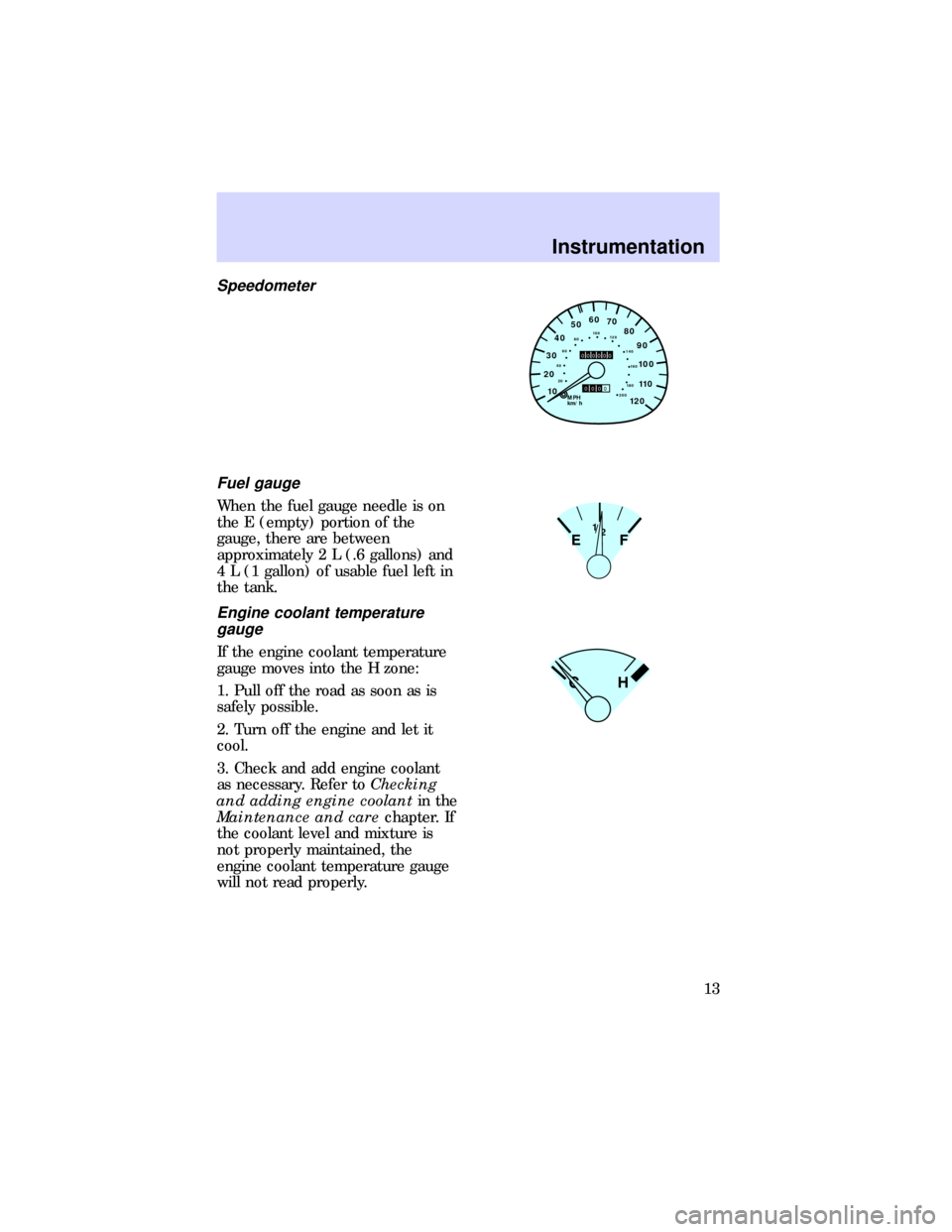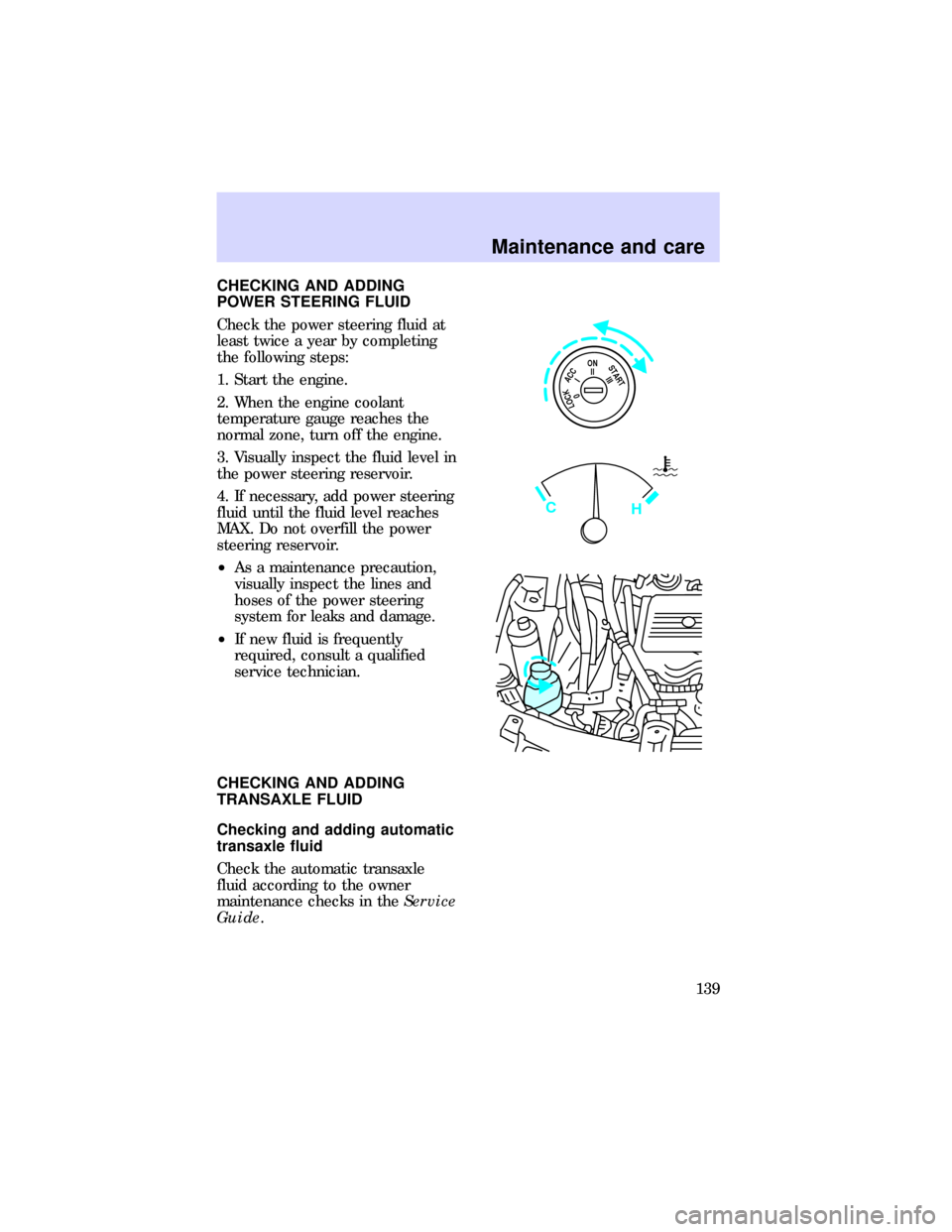coolant level FORD ESCORT 1997 6.G Owners Manual
[x] Cancel search | Manufacturer: FORD, Model Year: 1997, Model line: ESCORT, Model: FORD ESCORT 1997 6.GPages: 191, PDF Size: 2.02 MB
Page 10 of 191

Engine coolant
Illuminates when there is low
coolant level or a problem with the
engine coolant system. Stop the
vehicle and check the engine
coolant level as soon as possible.
The light will also briefly illuminate
when the ignition key is turned to
ON and the engine is off. For more
information on engine coolant,
refer toChecking and adding
engine coolantin the
Maintenance and carechapter.
Liftgate ajar (if equipped)
Illuminates when the ignition is in
the ON position and the liftgate is
open.
Many of the lights illuminate
briefly when you start the vehicle.
For more information on warning
light illumination, refer to
Preparing to start the vehiclein
theStartingchapter.
Warning chimes
Safety belt warning chime
For information on the safety belt
warning chime, refer to the
Seating and safety restraints
chapter.
Supplemental restraint system
(SRS) warning chime
For information on the SRS
warning chime, refer to the
Seating and safety restraints
chapter.
CHECK
COOLANT
Instrumentation
10
Page 13 of 191

Speedometer
Fuel gauge
When the fuel gauge needle is on
the E (empty) portion of the
gauge, there are between
approximately 2 L (.6 gallons) and
4 L (1 gallon) of usable fuel left in
the tank.
Engine coolant temperature
gauge
If the engine coolant temperature
gauge moves into the H zone:
1. Pull off the road as soon as is
safely possible.
2. Turn off the engine and let it
cool.
3. Check and add engine coolant
as necessary. Refer toChecking
and adding engine coolantin the
Maintenance and carechapter. If
the coolant level and mixture is
not properly maintained, the
engine coolant temperature gauge
will not read properly.
0000
000000
MPH
km/h
10 2030405060
70
80
90
10 0
12 011 020 4060
8010 0
12 0
16 0
18 0 140
200
EF1/2
CH
Instrumentation
13
Page 136 of 191

ADDING ENGINE COOLANT
Be careful not to add
engine coolant to the
windshield washer fluid reservoir.
If sprayed on the windshield,
engine coolant could make it
difficult to see through the
windshield.
When the engine is cool, add a
50/50 mixture of engine coolant
and water to the engine coolant
recovery reservoir Ð DO NOT
ADD DIRECTLY TO THE
RADIATOR. Add straight water
only in an emergency, but you
should replace it with a 50/50
mixture of coolant and distilled
water as soon as possible.
Check the coolant level in the
coolant recovery reservoir the next
few times you drive the vehicle. If
necessary, add enough of a 50/50
mixture of coolant and water to
bring the liquid level to the fill line
on the reservoir.
Never remove the coolant
recovery cap while the
engine is running or hot.
If you must remove the coolant
recovery cap, follow these steps
to avoid personal injury caused
by escaping steam or engine
coolant:
1. Before you remove the cap,
turn the engine off and let it
cool.
Maintenance and care
136
Page 138 of 191

produce coolant which meets Ford
specification ESE-M97B44-A, and
use of such coolant may harm
engine and cooling system
components.
Always dispose of used automotive
fluids in a responsible manner.
Follow your community's
regulations and standards for
recycling and disposing of
automotive fluids.
Coolant Refill Capacity
To find out how much fluid your
vehicle's cooling system can hold,
seeRefill capacities for fluidsin
the Index.
Have your dealer check the engine
cooling system for leaks if you
have to add more than a quart
(liter) of engine coolant per
month.
Severe Winter Climate
If you drive in extremely cold
climates (less than -34ÉF [-36ÉC]),
it may be necessary to increase the
coolant concentration above 50%.
Refer to the chart on the coolant
container to ensure the coolant
concentration in your vehicle is
such that the coolant will not
freeze at the temperature level in
which you drive during winter
months. Never increase the engine
coolant concentration above 60%.
Leave a 50/50 mixture of engine
coolant and water in your vehicle
year-round in non-extreme
climates.
Maintenance and care
138
Page 139 of 191

CHECKING AND ADDING
POWER STEERING FLUID
Check the power steering fluid at
least twice a year by completing
the following steps:
1. Start the engine.
2. When the engine coolant
temperature gauge reaches the
normal zone, turn off the engine.
3. Visually inspect the fluid level in
the power steering reservoir.
4. If necessary, add power steering
fluid until the fluid level reaches
MAX. Do not overfill the power
steering reservoir.
²As a maintenance precaution,
visually inspect the lines and
hoses of the power steering
system for leaks and damage.
²If new fluid is frequently
required, consult a qualified
service technician.
CHECKING AND ADDING
TRANSAXLE FLUID
Checking and adding automatic
transaxle fluid
Check the automatic transaxle
fluid according to the owner
maintenance checks in theService
Guide.
ON
II
ACC
I
LOCK
0
START
III
C
H
Maintenance and care
139